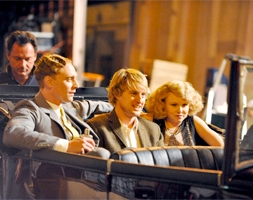Midnight in Paris
Posted on May 26, 2011 at 6:00 pm
B+| Lowest Recommended Age: | High School |
| MPAA Rating: | Rated PG-13 for some sexual references and smoking |
| Profanity: | Some strong language |
| Alcohol/ Drugs: | Drinking, smoking |
| Violence/ Scariness: | None |
| Diversity Issues: | None |
| Date Released to Theaters: | May 27, 2011 |
| Date Released to DVD: | December 20, 2011 |
| Amazon.com ASIN: | B005MYEQ4U |
Woody Allen’s best film in years is a nostalgic tribute to nostalgia. And this is one you’ll enjoy more by knowing less, so consider this entire review a spoiler alert and stop now if you want to preserve all of its surprises.
It begins with postcard Paris, a series of shots of iconic locations and a rueful jazz score. 
Gil Pender (Owen Wilson) is a successful Hollywood writer who longs for something richer and more challenging. He has come to Paris with his fiancee, Inez (Rachel McAdams, doing her best in a thin role), and her parents, caricature Californians who prefer Napa Valley wine and American movies, even when they are in France. A character calls him Miniver Cheevy because he romanticizes the Paris of the past, when Hemingway and Fitzgerald wrote and drank and things seemed — at least in retrospect — simpler and filled with promise. It all seems even more appealing as he struggles to do the writing he says he wants to do and fumes as Inez seems enthralled by Paul, a fatuous know-it-all (Michael Sheen).
Okay, now spoiler alert again — stop reading if you don’t want to know what happens. One night, when Inez has gone dancing with Paul and his girlfriend, Gil goes for a walk. Just as the clock chimes twelve, a car pulls up and he is beckoned inside. At first, he thinks he has happened upon a costume party, but then he realizes that he is not talking to a couple dressed as Scott and Zelda Fitzgerald (Tom Hiddleston and Alison Pill); he is speaking to the legendary writers, and seeing them when they were young and happy and excited by the world around them. He meets his heroes. They accept him as one of them. He begins to live the life he believes he was meant to live — but only at midnight.
And there’s a girl. Marion Cotillard plays a free-spirited but warm-hearted girl who has had relationships with some of the now-legendary names of the era. And Gil is engaged. But she and Gil are drawn to each other and suddenly the only thing he can remember that he has in common with Inez is a fondness for Naan bread.
Allen makes no attempt to re-create the historical Paris of the lost generation. Part of the charm of the story is the way that it is very much Gil’s idealized dream of the era, with all of the now-famous names friendly and obliging. Gertrude Stein (Kathy Bates) is perfectly happy to read his novel (about a man who owns a nostalgia shop) and give him both encouragement and constructive suggestions. Just from reading what Gil wrote, a famous author (portrayed with great wit and gusto by Corey Stoll) has insights about Inez that Gil could not see. In a Jungian sense, each of the real-life characters is here simply as a manifestation of some aspect of Gil, a way for him to think through things he has been too successful to consider. When the story takes an “Inception”-like inverted twist, Gil begins to understand, like Dorothy Gale of Kansas, that the power is inside him when it is time to go home.
The retro scenes are brimming with charm, an all-star parade of early 20th century luminaries, charmingly written and beautifully portrayed. They may be Gil’s projections, but they are enchanting. The opening postcard shots shimmer into the dream of Paris and we embrace it as happily as Gil does, swept up in the bittersweet nostalgia you can only feel for something you never really experienced. Those midnight excursions for Gil are what movies like this one are for us, an emotional vacation that, if we are lucky, provides respite, clarity, and renewal. Allen continues his exploration of the great capitals of Europe next year with Rome. I’m nostalgic for it already.
Parents should know that this film has smoking, drinking, and sexual references.
Family discussion: When do you think was the greatest period of art and creative opportunity? What writers and artists would you like to meet?
If you like this, try: reading about the artistic community in Paris between the wars and Woody Allen’s films, “The Purple Rose of Cairo” and “Radio Days”

I really like your insight that the visits to the past operate for Gil as films (like this one) can work for us!
Midnight in Paris a B+? I beg to differ but my husband nor I enjoyed it. We found it entirely too slow therefore had a hard time staying with it.
Thanks, D — I’m always glad to hear another view and your comment will be very helpful to those who are trying to decide whether it is right for them.
I couldn’t find the review for Midnight in Paris in the alphabetical listing. Is it filed under something other than “M”?
Thanks, Susan. We’re fixing the archive and I hope it will work better soon.